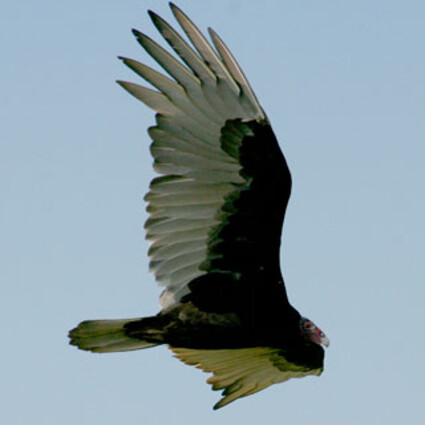They're baaaaaack! The TVs that is.
Last updated 4/15/2014 at Noon
Wednesday, March, 19, 2014: That was the day that the turkey vultures, aka buzzards or TVs, appeared over the horizon, winging their way north from their long (and very wise) winter stay in the southern climes.
The official birding world acronym is TUVU. TUVUs, like many Sisters Country birds (and retired homo sapiens, known as snow birds) must obey the sun. The length of day, the position of the sun in relation to the horizon are two components of daylight that trigger the ancient call that tells birds to get-the-kelly outta' here before they freeze their you-know-what off, and the same position of the sun tells them to come back north and make babies.
Unlike hummingbirds who, when caught by a sudden cold spell, can shut down and go into a state of torpidity until it passes, vultures have to weather the storm. (Torpid, from the Latin: torpidus, numb; to be inactive or sluggish, as in dormant, a hibernating or estivating animal.)
TVs are large birds, with a wingspan of 63 to 72 inches. They have a body length from 24 to 32 inches (the female is the larger), and, "our" vultures - which inhabit the northern limits of the species' range - average around 4.4 pounds. The sexes are identical in plumage and in coloration, so you have to observe them closely, as the female is slightly larger. While soaring, the turkey vulture holds its wings in a shallow V-shape and often tips from side to side.
Turkey vultures and the rest of the clean-up crew, i.e. black vultures and condors are NOT raptors. That is, they DO NOT ordinarily kill prey for food; they are scavengers who rid the countryside of awful offal.
Biologically, the scavengers are known as cathartiformes, which from the Latin means "purifiers," and are biologically related more closely to storks than eagles. There is, however, a group of scientists who would like to keep the vultures in the order falconiformes, which contains the raptors. Your choice...
And while we're on the subject of "biological" classification, there are five recognized subspecies of TUVUs. Cathartes aura meridonalis is our subspecies and breeds from Manitoba to British Columbia, Alberta south to Arizona, Texas and to Baja California.
The common name turkey vulture wasn't pinned on them because they eat or sound like turkeys; it's because of the "bald" head and dark plumage, similar to the so-called wild turkey. Vulture is from the Latin: vultures, "tearer." (If you've ever witnessed a vulture getting into a dead road-killed deer you can appreciate the "tearer" business.)
In case you're wondering how long vultures live, one was known to reach the ripe old age of 40 years in a zoo - but out in the wild, if they get to about 16 years, they're doing really well.
The Oregon Department of Transportation (ODOT) maintains several well-concealed, out-of-the-way and un-named graveyards where they deposit road-killed creatures. These sites are well away from the highway and extremely important for scavengers to go about their grisly work of recycling dead animals.
In today's helter-skelter traffic of people driving motor vehicles at well-over-the-speed-limit velocities, such out-of-the-way sites are very safe for raptors. Bald and golden eagles, along with several owls, hawks, woodpeckers, ravens and other birds, do not pass up a free meal. If the dead animals were left alongside the road, a whole lot of birds would also be killed, along with coyotes and other scavengers.
Residents close to Three Creek Road and Swede Ridge trailhead know that TVs are communal, they enjoy and require the company of their kind. Every night they come in to roost in the big cottonwoods along the road. If you're one who enjoys birds as much as I do, this daily ritual is always a lot of fun to observe, as individual tearers coming in to roost always do it differently.
The TVs primary form of defense is regurgitating semi-digested meat - the awful offal that deters most creatures from raiding its nest or violating it's comfort zone. Be warned! It will also sting if you get close enough to get the vomit in your eyes.
While TVs are excellent soaring birds, they are very clumsy and almost comical landing birds. One TV knocking another off the limb the lander is heading for is a constant source of entrainment for the viewing public, but frustration for vultures. By the time the sun is long-gone, however, the constant juggling and shoving usually settles down, and if vultures had a syrinx (voice box) you could hear them snoring.
Vultures forage by smell - a tool that is uncommon in the avian world. They often soar low to the ground in their tippy-tippy flight to pick up the scent of ethyl mercaptan gas produced by the beginnings of decay in dead animals.
Hikers and bikers along Three Creek Road may often see vultures standing in a spread-winged stance (known as the horaltic pose) that serves multiple functions: drying the wings, warming the body, and baking off bacteria.
Eggs are generally laid in the nesting site in a protected location such as a cliff, a cave, a rock crevice, a burrow, and sometimes inside a hollow tree. For years, I searched out nests and banded nestling TVs to gain more knowledge of their range, longevity and reason for mortality. But when it was discovered they defecate and urinate down their legs to control body temperature, leg-banding was no longer used and patagial wing markers are now used. WATCH FOR THEM!

















Reader Comments(0)